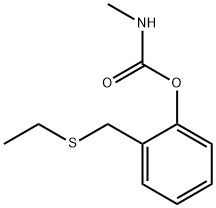BENFURACARB
- CAS NO.:82560-54-1
- Empirical Formula: C20H30N2O5S
- Molecular Weight: 410.53
- MDL number: MFCD16661230
- EINECS: 200-589-5
- SAFETY DATA SHEET (SDS)
- Update Date: 2024-12-18 14:15:30

What is BENFURACARB?
Chemical properties
Benfuracarb is a thick liquid.
The Uses of BENFURACARB
Benfuracarb is a benzofuranyl methylcarbamate based insecticide used to control aphids, springtails and other pests usually on beet crops.
The Uses of BENFURACARB
Benfuracarb is a contact and ingested insecticide. It is used to control insect pests in citrus, maize, rice, sugar beet and vegetables. It is active against Chrysomelidae, Elateridae, Aphididae, Lissorhoptrus oryzophilus and Plutella xylostella.
Definition
ChEBI: Benfuracarb is a carbamate ester, a member of 1-benzofurans and an ethyl ester. It has a role as an EC 3.1.1.7 (acetylcholinesterase) inhibitor, a carbamate insecticide and an agrochemical.
Potential Exposure
A benzofuranyl methylcarbamate insecticide, nematicide. Not registered for use in the United States.
Metabolic pathway
When 14C-benfuracarb is applied topically to houseflies, the houseflies metabolize benfuracarb easily to form carbofuran which in turn is oxidized at the 3-position of the ring and N-methyl group, resulting in further conjugates of the metabolites. Major metabolites are carbofuran, 3-hydroxycarbofuran, N- hydroxymethylcarbofuran, 3-ketocarbofuran, 2,3- dihydro-2,2-dimethyl-3-hydroxybenzofuran-6-ol, 3- hydroxy-N-hydroxymethylcarbofuran, and 3-keto-N- hydroxymethylcarbofuran.
Shipping
UN 2992 Carbamate pesticides, liquid, toxic, Hazard Class: 6.1; Labels: 6.1—Poisonous materials.
Degradation
Benfuracarb is stable in neutral and weakly basic media but unstable in strongly acidic or basic conditions. It is degraded by sunlight (PM). A methanolic solution of unlabelled benfuracarb was coated on a glass plate or applied to soil on a plate and irradiated with a high pressure Hg lamp (125 W). Details not given were the emission spectrum of the lamp, the experimental sample temperatures and the irradiation periods. After irradiation, samples were analysed by TLC methods. The methanol solution turned a deep brown on irradiation and four major and three minor products were formed (see Scheme 1). The major products were a cleavage product (2), the phenol (5) and carbofuran (6). Minor amounts of the dimeric compounds 3 and 4 were detected. On soil, three photoproducts were the phenol (5), carbofuran (6) and the cleavage product (7). On a glass surface four products were the phenol (5), carbofuran (6) and the cleavage products 2 and 7. No products of oxidation were reported (Dureja et al., 1990).
Incompatibilities
Carbamates are incompatible with reducing agents, strong acids, oxidizing acids, peroxides, and bases. Contact with active metals or nitrides cause the release of flammable, and potentially explosive, hydrogen gas. May react violently with bromine, ketones. Incompatible with azo dyes, caustics, ammonia, amines, boranes, hydrazines, strong oxidizers.
Waste Disposal
Do not discharge into drains or sewers. Dispose of waste material as hazardous waste using a licensed disposal contractor to an approved landfill. Consult with environmental regulatory agencies for guidance on acceptable disposal practices. Incineration with effluent gas scrubbing is recommended. Containers must be disposed of properly by following package lab el directions or by contacting your local or federal environmental control agency, or by contacting your regional EPA office.
Properties of BENFURACARB
| Melting point: | <25℃ |
| Boiling point: | 110℃ (0.023mmHg) |
| Density | 1.172 |
| vapor pressure | 2.7 x 10-5 Pa (20 °C) |
| refractive index | 1.6510 (estimate) |
| Flash point: | 100 °C |
| storage temp. | 0-6°C |
| solubility | Chloroform (Slightly), DMSO, Ethyl Acetate (Slightly), Methanol (Slightly) |
| pka | 2.05±0.70(Predicted) |
| form | neat |
| Water Solubility | 8 mg l-1 (20 °C) |
| Specific Gravity | 1.142 (20℃) |
| Merck | 13,1039 |
| EPA Substance Registry System | Benfuracarb (82560-54-1) |
Safety information for BENFURACARB
| Signal word | Danger |
| Pictogram(s) |
 Skull and Crossbones Acute Toxicity GHS06  Health Hazard GHS08  Environment GHS09 |
| GHS Hazard Statements |
H410:Hazardous to the aquatic environment, long-term hazard |
| Precautionary Statement Codes |
P202:Do not handle until all safety precautions have been read and understood. P261:Avoid breathing dust/fume/gas/mist/vapours/spray. P264:Wash hands thoroughly after handling. P264:Wash skin thouroughly after handling. P273:Avoid release to the environment. P301+P310:IF SWALLOWED: Immediately call a POISON CENTER or doctor/physician. |
Computed Descriptors for BENFURACARB
New Products
Tert-butyl bis(2-chloroethyl)carbamate 4-Methylphenylacetic acid N-Boc-D-alaninol N-BOC-D/L-ALANINOL 3-Morpholino-1-(4-nitrophenyl)-5,6-dihydropyridin- 2(1H)-one Furan-2,5-Dicarboxylic Acid Tropic acid DIETHYL AMINOMALONATE HYDROCHLORIDE 1,1’-CARBONYLDIIMIDAZOLE R-2-BENZYLOXY PROPIONIC ACID 1,1’-CARBONYLDI (1,2-4 TRIAZOLE) N-METHYL INDAZOLE-3-CARBOXYLIC ACID (2-Hydroxyphenyl)acetonitrile 4-Bromopyrazole 5-BROMO-2CYANO PYRIDINE 5,6-Dimethoxyindanone 5-broMo-2-chloro-N-cyclopentylpyriMidin-4-aMine 2-(Cyanocyclohexyl)acetic acid 4-methoxy-3,5-dinitropyridine 2-aminopropyl benzoate hydrochloride 1-(4-(aminomethyl)benzyl)urea hydrochloride diethyl 2-(2-((tertbutoxycarbonyl)amino) ethyl)malonate tert-butyl 4- (ureidomethyl)benzylcarbamate Ethyl-2-chloro((4-methoxyphenyl)hydrazono)acetateRelated products of tetrahydrofuran
You may like
-
 Benfuracarb 98.00% CAS 82560-54-1View Details
Benfuracarb 98.00% CAS 82560-54-1View Details
82560-54-1 -
 Benfuracarb CAS 82560-54-1View Details
Benfuracarb CAS 82560-54-1View Details
82560-54-1 -
 1975-50-4 98%View Details
1975-50-4 98%View Details
1975-50-4 -
 2-HYDROXY BENZYL ALCOHOL 98%View Details
2-HYDROXY BENZYL ALCOHOL 98%View Details
90-01-7 -
 2-Chloro-1,3-Bis(Dimethylamino)Trimethinium Hexafluorophosphate 221615-75-4 98%View Details
2-Chloro-1,3-Bis(Dimethylamino)Trimethinium Hexafluorophosphate 221615-75-4 98%View Details
221615-75-4 -
 14714-50-2 (2-Hydroxyphenyl)acetonitrile 98+View Details
14714-50-2 (2-Hydroxyphenyl)acetonitrile 98+View Details
14714-50-2 -
 118753-70-1 98+View Details
118753-70-1 98+View Details
118753-70-1 -
 733039-20-8 5-broMo-2-chloro-N-cyclopentylpyriMidin-4-aMine 98+View Details
733039-20-8 5-broMo-2-chloro-N-cyclopentylpyriMidin-4-aMine 98+View Details
733039-20-8







